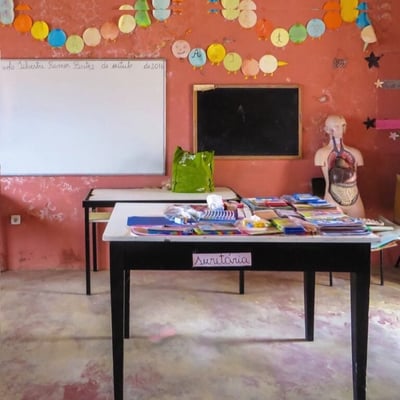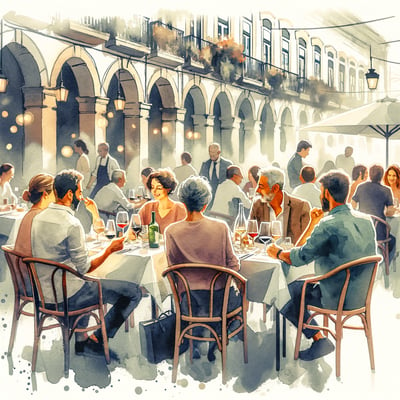1
00:00:01,805 –> 00:00:02,865
2
00:00:02,865 –> 00:00:04,105
Fernando: Olá, mãe.
{{Fernando: Hi, Mom.}}
3
00:00:04,105 –> 00:00:05,165
Entra.
{{Come in}}
4
00:00:05,165 –> 00:00:07,025
Dona Ana: Olá, filho!
{{Dona Ana: Hello, Son!}}
5
00:00:07,025 –> 00:00:08,885
Fernando: Obrigado por vires.
{{Fernando: Thank you for coming.}}
6
00:00:08,885 –> 00:00:11,145
Eu e a Sara temos de trabalhar
{{Sara and I have to work}}
7
00:00:11,145 –> 00:00:12,365
e a nossa ama está de férias,
{{and our babysitter is on vacation}}
8
00:00:12,545 –> 00:00:14,545
não pode ficar com o Bruno.
{{she cannot stay with Bruno.}}
9
00:00:15,245 –> 00:00:19,585
Dona Ana: Eu sei, eu sei, eu fico com ele.
{{Dona Ana: I know, I know, I will stay with him.}}
10
00:00:19,585 –> 00:00:23,425
Mas vocês os dois trabalham muito!
{{But you two work too much!}}
11
00:00:23,425 –> 00:00:25,585
Eu imagino que tu comes pouco.
{{I imagine you eat little.}}
12
00:00:25,585 –> 00:00:27,385
Olha esses braços.
{{Look at those arms.}}
13
00:00:27,385 –> 00:00:28,905
Fernando: O que têm estes braços?
{{Fernando: What’s wrong with these arms? (“What do these arms have?”)}}
14
00:00:28,985 –> 00:00:32,305
Dona Ana: Não têm carne, olha para isso!
{{Dona Ana: They don’t have meat, look at that!}}
15
00:00:32,314 –> 00:00:35,375
Fernando: É porque estão sempre a segurar o Bruno.
{{Fernando: It’s because they’re always holding Bruno.}}
16
00:00:35,375 –> 00:00:38,705
Dona Ana: Pois, eu entendo.
{{Dona Ana: Yeah, I understand.}}
17
00:00:38,705 –> 00:00:42,545
Mas vocês também têm de cuidar de vocês.
{{But you also have to take care of you.}}
18
00:00:42,545 –> 00:00:45,345
Isso é o teu almoço?
{{Is that your lunch?}}
19
00:00:45,345 –> 00:00:48,245
Espera, eu posso cozinhar uma sopa
{{Wait, I can cook a soup}}
20
00:00:48,245 –> 00:00:50,185
e faço uma salada também.
{{and make a salad too.}}
21
00:00:50,195 –> 00:00:51,655
Isso não chega.
{{That’s not enough.}}
22
00:00:51,655 –> 00:00:53,425
Fernando: Isto chega!
{{Fernando: It’s enough!}}
23
00:00:53,425 –> 00:00:55,085
Mas obrigado.
{{But thank you.}}
24
00:00:55,085 –> 00:00:57,765
Dona Ana: E a casa, filho?
{{Dona Ana: What about the house, Son?}}
25
00:00:57,775 –> 00:01:01,585
Aquelas janelas estão sujas, não vês?
{{Those windows are dirty, don’t you see?}}
26
00:01:01,585 –> 00:01:03,585
E aquele chão também.
{{And that floor too.}}
27
00:01:03,585 –> 00:01:04,585
Fernando: Mãe…
{{Fernando: Mom…}}
28
00:01:04,585 –> 00:01:08,445
Dona Ana: Ah, mas estas cadeiras são novas.
{{Dona Ana: Ah, but these chairs are new.}}
29
00:01:08,445 –> 00:01:10,325
Muito giras.
{{Very cute.}}
30
00:01:10,325 –> 00:01:14,005
E aquele café, é para ti?
{{And that coffee, is that for you?}}
31
00:01:14,005 –> 00:01:16,525
É por causa daquilo que não dormes bem!
{{It is because of that [the coffee] you do not sleep well!}}
32
00:01:16,525 –> 00:01:18,725
Fernando: Mãe, por favor.
{{Fernando: Mom, please.}}
33
00:01:18,725 –> 00:01:21,125
Dona Ana: Pronto, não falo mais.
{{Dona Ana: Okay, I won’t say any more.}}
34
00:01:21,125 –> 00:01:23,365
Mas isto preocupa-me.
{{But this worries me.}}
35
00:01:23,365 –> 00:01:24,474
Fernando: Tudo te preocupa!
{{Fernando: Everything worries you!}}
 We respect your privacy and have a ZERO TOLERANCE for spam.
We respect your privacy and have a ZERO TOLERANCE for spam.
















Hi!
What kind of tense is the sentence from Fernando: “Obrigado por vires.” ? When and how do use it?
Hi! So, this is the verb “vir” in the personal infinitive form. I’m afraid it’s a bit too complex to explain in a single comment, but it would be a great topic to cover in an upcoming Learning Note, so let me make a mental note to do just that and notify you once it’s available 🙂 Feel free to remind me via our contact page!
Please explain in the sentence “Obrigado por vires”, what tense is used with ” vires” ? Infinitivo flexionado or presente conjuntivo of vir.
Hi, Zoran. This is the personal infinitive (infinitivo pessoal/flexionado). It looks very similar to the future (not present!) subjunctive of the verb vir, but that would actually be “vieres“, not “vires” 🙂
So all the Portuguese mothers are the same!
Ahaha, allegedly!
Great
A very useful session illustrating the use of demonstrativos. I do have one minor question, however. Why does Dona Ana switch to the plural by saying “Mas vocês também tem de cuidar de vocês“ when she is solely addressing Fernando? Or is she implying that both Fernando and Sara have to take care of themselves?
Thank you for your comment! As you guessed, Dona Ana switches to the plural because even though she’s alone with Fernando (and the baby), she’s referring to both him and Sara 🙂
é muito bem para a pronúcia,
obrigada
I see that the combination “ter+de” is used (they have to work). I’ve been taught that it’s “ter+que”. Is there any difference?
Nowadays most people use them interchangeably, but here’s a more in-depth explanation: Ter de vs. Ter que
Thanks for the link tip! Interesting
I struggled with the audio in this one. Some sentences were clear enough, but I just couldn’t make sense of a lot of what was being said. Take this section for example:
Eu e a Sara temos de trabalhar
e a nossa ama está de férias,
não pode ficar com o Bruno.
Looks easy enough, right? This was what I put together after listening to it multiple times at .7x:
Eu ou e essar a temos de trabalhar.
E ou não sei um está de férias.
Não pode ficar de Bruno.
I knew a lot of this was wrong of course but I was basically writing down the closest phonetic match that I could. Sometimes something clicks when I do this, but often I have no clue. I think the biggest issue is how fast the the characters in these stories speak, particularly compared to the clearly enunciated audio clips in the lessons. I know it’s all a matter of pattern recognition and I just need more exposure to the language. Hopefully a year from now these Shorties won’t be quite so daunting.
Yes I think a lot of it does come down to pattern recognition and I think it will get better over time.
I wonder if it would help to listen through a few times first with the English translation to get the general meaning down. And then a few times with the Portuguese only — just listening and reading the Portuguese simultaneously.
This should help you start to hear how the written words match to the sounds and prepare your brain for what you will hear. Then when you try to write down what you hear, you will already have a bit of a preview to help your brain start to hear those patterns independently.
I just realized I can change the audio speed🤦🏼♀️ I always “read” it first w the english and do the expressions and vocabulary before I listen and that helps me. But I still need it all in slow motion so my brain can catch up
I was thinking of doing exactly that in the next Shorty, or at least follow along with the Portuguese while listening to the audio. It feels like cheating but I think it will pay off in the long run.
I think it will pay off too! It’s only cheating if you’re not challenging yourself at all anymore. 🙂 But this will still be a challenge and a good listening exercise that is like a step in-between the Lessons and the Shorties.
Thank you for this dialogue. I always look forward to your dialogues !
Talking about demonstratives… Why does Dona Ana say: “AQUELAS janelas estao sujas” but “ESTAS cadeiras sao novas”. I’m trying to imagine the scene… Has she approached the chairs and she is very close?
That’s great to read, Agnieszka, thank you too 🙂
Regarding demonstratives, they’re usually chosen based on relative distance between the speaker and whatever they’re talking about. In this case, you can visualize Dona Ana being or coming close to the chairs (using ‘estas’ for them), while pointing to the windows on the other end of the room, far from her (using ‘aquelas’). There’s also ‘essas’, which she could use if she were talking about something far from her, but close to Fernando.
This Learning Note covers all three demonstratives: Variable Demonstratives: Singular
Thank you. That’s exactly what I thought imaging Dona Ana at her son’s place !
When the grandmother says look at the the arms Olha esses braços / look at those arms . Fernando replies “O que têm estes braços ? ” Literally this translates to “What have these arms” . The translation also says “What´s wrong with these arms.” Can I use this as a general expression when I want to say What´s wrong with something ie O que tem esta maquina hoje ?
Yes, you can, we often use it like that 🙂 You can also say, for example, “O que é que se passa com [X]?” (What’s up with [X]?)
It is great to know that the vocabulary and the expressions are being expanded even as we work on the shorty. We get so much from the pronounciation. I also discovered that if I hold the cursur over a specific phrase, I can listen to and repeat is over and over. It wakes you realize how talented and expressive the speakers Eliana and Joseph are!
Dona Ana says “eu fico com ele”. Would it not be right to say “eu fico consigo” instead? Thanks..
Olá! “Consigo” can only be used 1) reflexively, for the 3rd-person singular; or 2) referring to “você” (which in any case, also functions grammatically as a 3rd-person pronoun, so this still fits in rule #1).
Some examples of both cases:
– Pedro, eu posso ir consigo? (Pedro, can I go with you?) – referring to você
– Nós precisamos de falar consigo. (We need to talk to you) – referring to você
– Ele trouxe tudo consigo. (He brought everything with him) – reflexive use, referring back to the subject
– Ela falou consigo mesma. (She spoke with herself) – reflexive use, referring back to the subject
In this case, Dona Ana is talking about a third-person (her grandchild), and this is neither a reflexive use nor a reference to “você”. So, only “com ele” is appropriate.